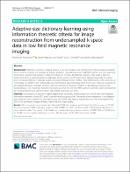| dc.contributor.author | Emmanuel, Ahishakiye | |
| dc.contributor.author | Martin, Bastiaan Van Gijzen | |
| dc.contributor.author | Julius, Tumwiine | |
| dc.contributor.author | Johnes, Obungoloch | |
| dc.date.accessioned | 2023-04-14T12:36:43Z | |
| dc.date.available | 2023-04-14T12:36:43Z | |
| dc.date.issued | 2020-06 | |
| dc.identifier.citation | Ahishakiye, E., Van Gijzen, M. B., Tumwiine, J., & Obungoloch, J. (2020). Adaptive-size dictionary learning using information theoretic criteria for image reconstruction from undersampled k-space data in low field magnetic resonance imaging. BMC medical imaging, 20, 1-12. | en_US |
| dc.identifier.uri | https://doi.org/10.1186/s12880-020-00474-3 | |
| dc.identifier.uri | https://hdl.handle.net/20.500.12504/1305 | |
| dc.description.abstract | Background
Magnetic resonance imaging (MRI) is a safe non-invasive and nonionizing medical imaging modality that is used to visualize the structure of human anatomy. Conventional (high-field) MRI scanners are very expensive to purchase, operate and maintain, which limit their use in many developing countries. This study is part of a project that aims at addressing these challenges and is carried out by teams from Mbarara University of Science and Technology (MUST) in Uganda, Leiden University Medical Center (LUMC) in the Netherlands, Delft University of Technology (TU Delft) in the Netherlands and Pennsylvania State University (PSU) in the USA. These are working on developing affordable, portable and low-field MRI scanners to diagnose children in developing countries with hydrocephalus. The challenges faced by the teams are that the low-field MRI scanners currently under development are characterized by low Signal-to-Noise Ratio (SNR), and long scan times.
Methods
We propose an algorithm called adaptive-size dictionary learning algorithm (AS-DLMRI) that integrates information-theoretic criteria (ITC) and Dictionary learning approaches. The result of the integration is an adaptive-size dictionary that is optimal for any input signal. AS-DLMRI may help to reduce the scan time and improve the SNR of the generated images, thereby improving the image quality.
Results
We compared our proposed algorithm AS-DLMRI with adaptive patch-based algorithm known as DLMRI and non-adaptive CSMRI technique known as LDP. DLMRI and LDP have been used as the baseline algorithms in other related studies. The results of AS-DLMRI are consistently slightly better in terms of PSNR, SNR and HFEN than for DLMRI, and are significantly better than for LDP. Moreover, AS-DLMRI is faster than DLMRI.
Conclusion
Using a dictionary size that is appropriate to the input data could reduce the computational complexity, and also the construction quality since only dictionary atoms that are relevant to the task are included in the dictionary and are used during the reconstruction. However, AS-DLMRI did not completely remove noise during the experiments with the noisy phantom. Our next step in our research is to integrate our proposed algorithm with an image denoising function. | en_US |
| dc.language.iso | en | en_US |
| dc.publisher | BMC Medical Imaging | en_US |
| dc.subject | Compressed sensing, | en_US |
| dc.subject | Dictionary learning, | en_US |
| dc.subject | Image reconstruction, | en_US |
| dc.subject | Information-theoretic criteria, | en_US |
| dc.subject | Low-field MRI | en_US |
| dc.title | Adaptive-size dictionary learning using information theoretic criteria for image reconstruction from undersampled k-space data in low field magnetic resonance imaging | en_US |
| dc.type | Article | en_US |

